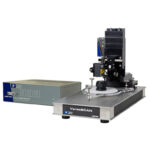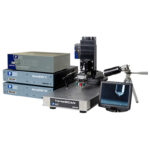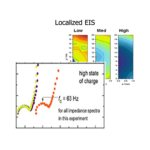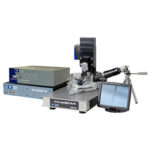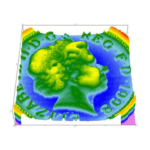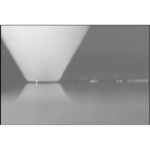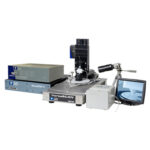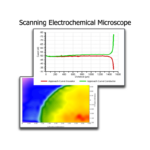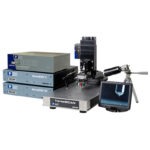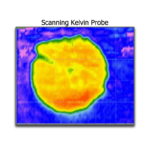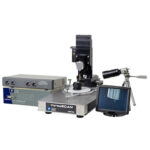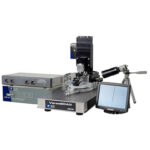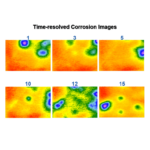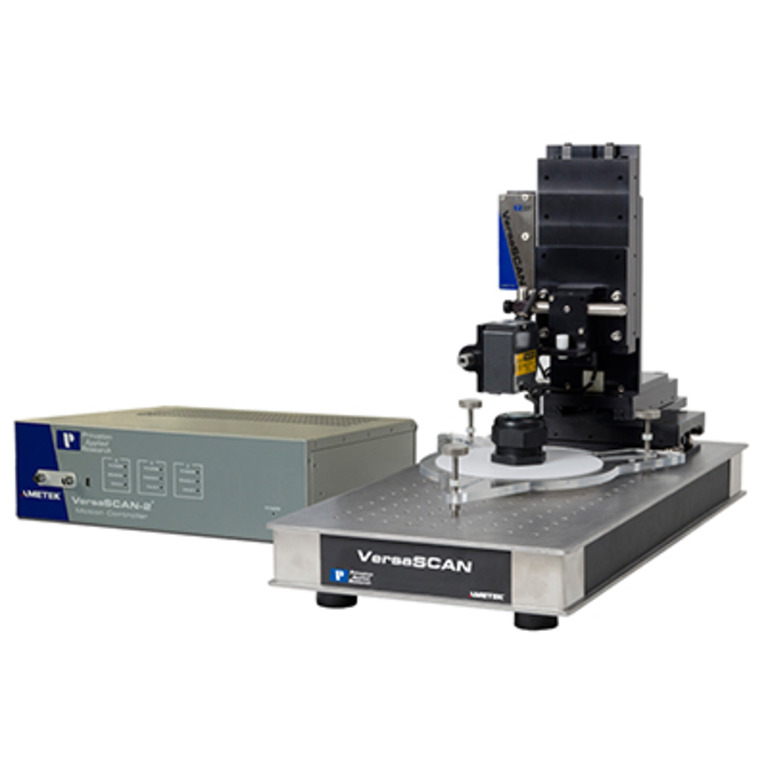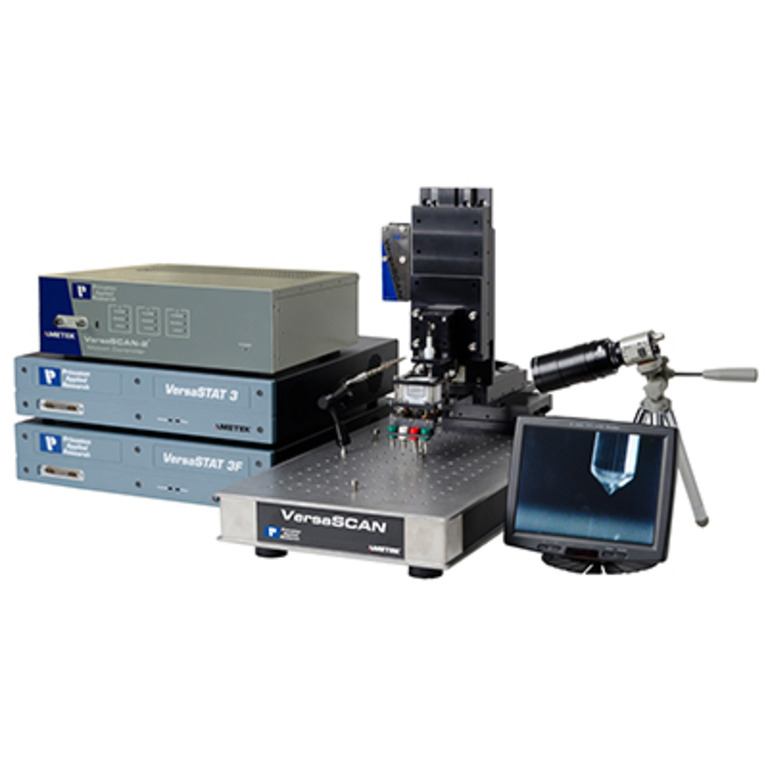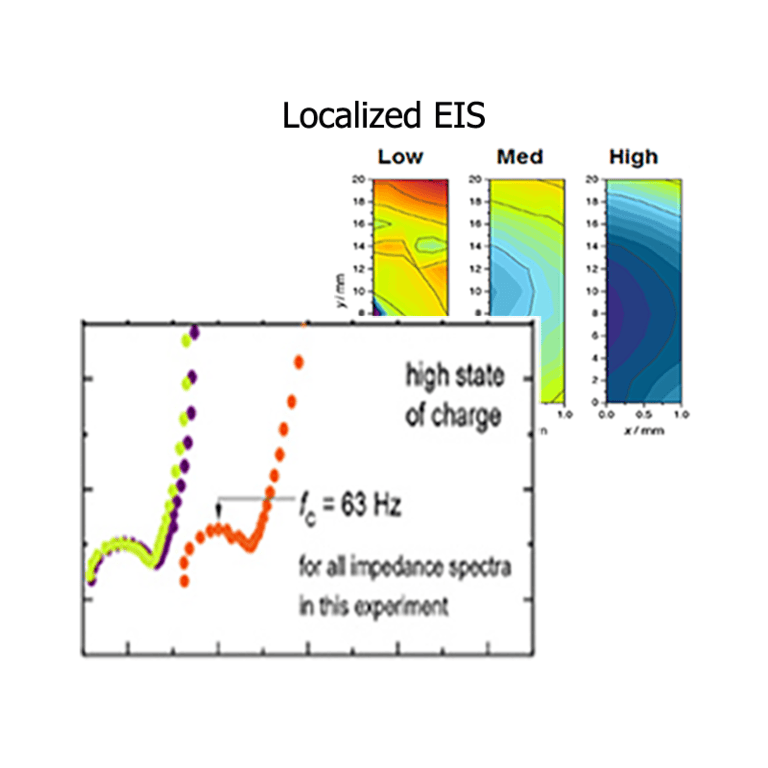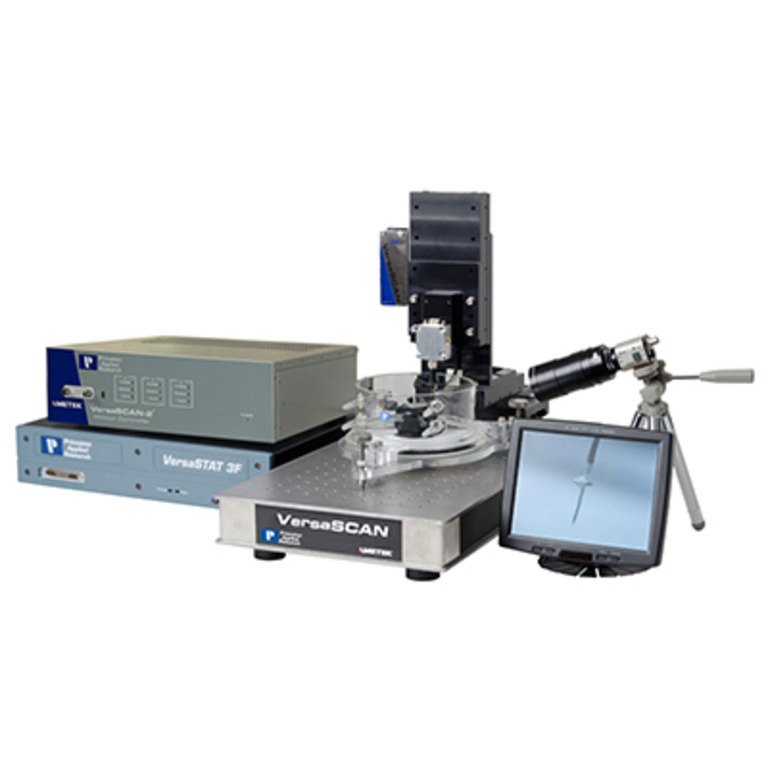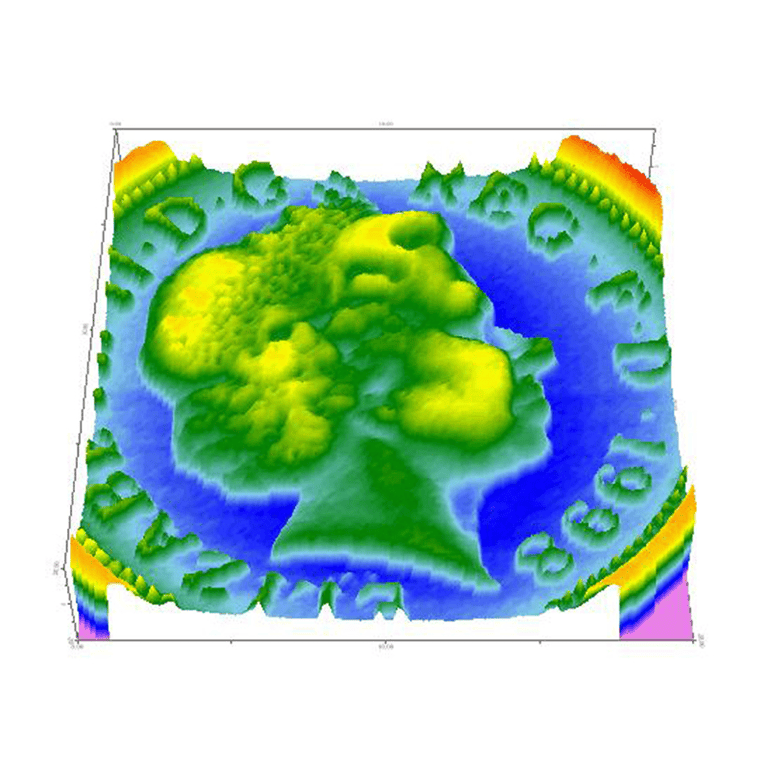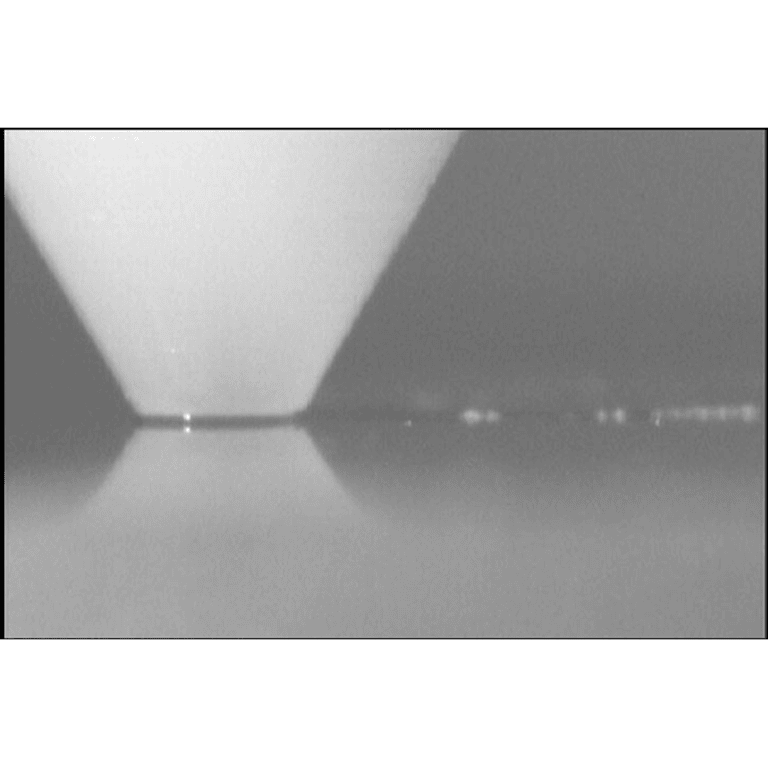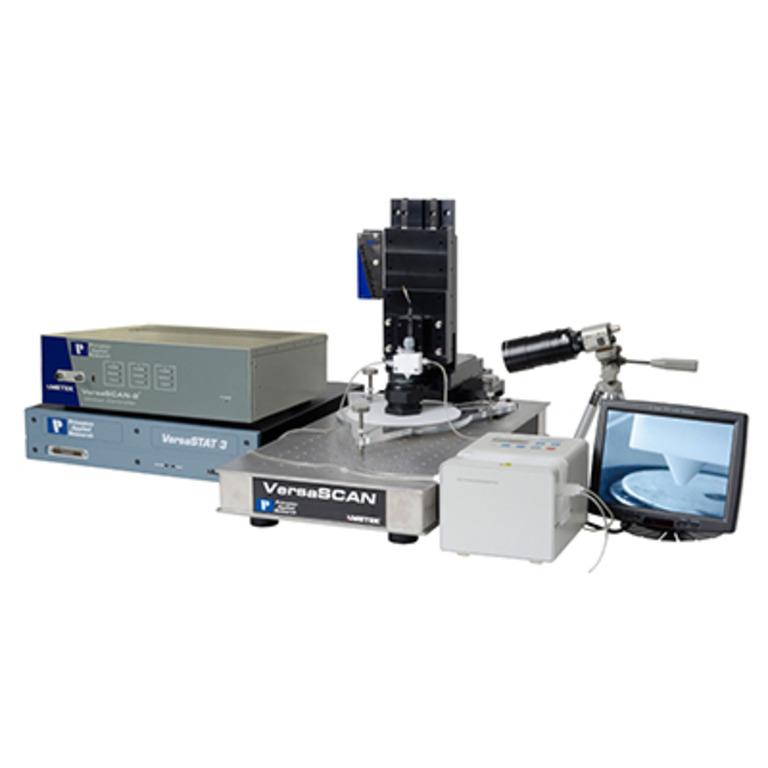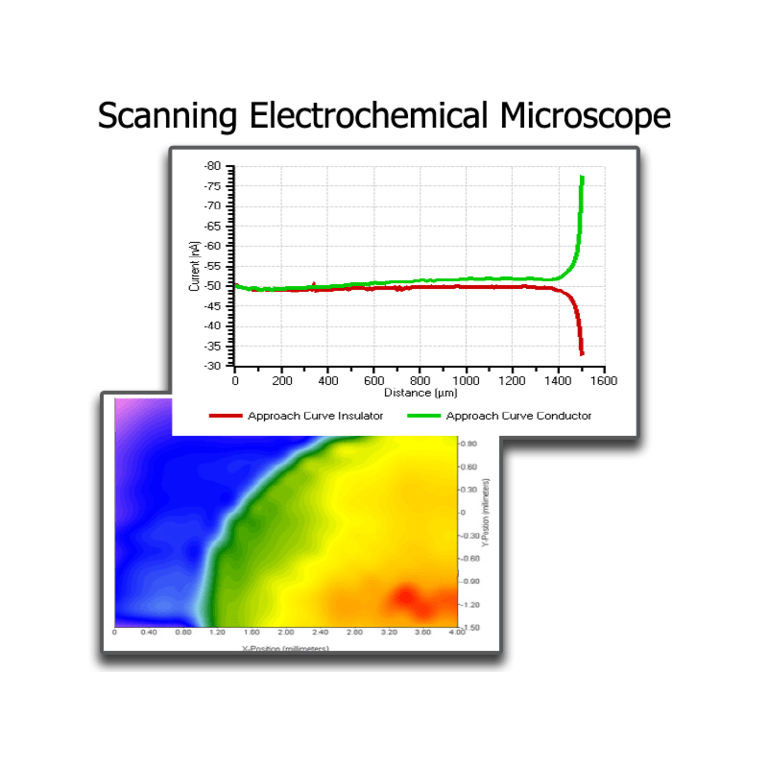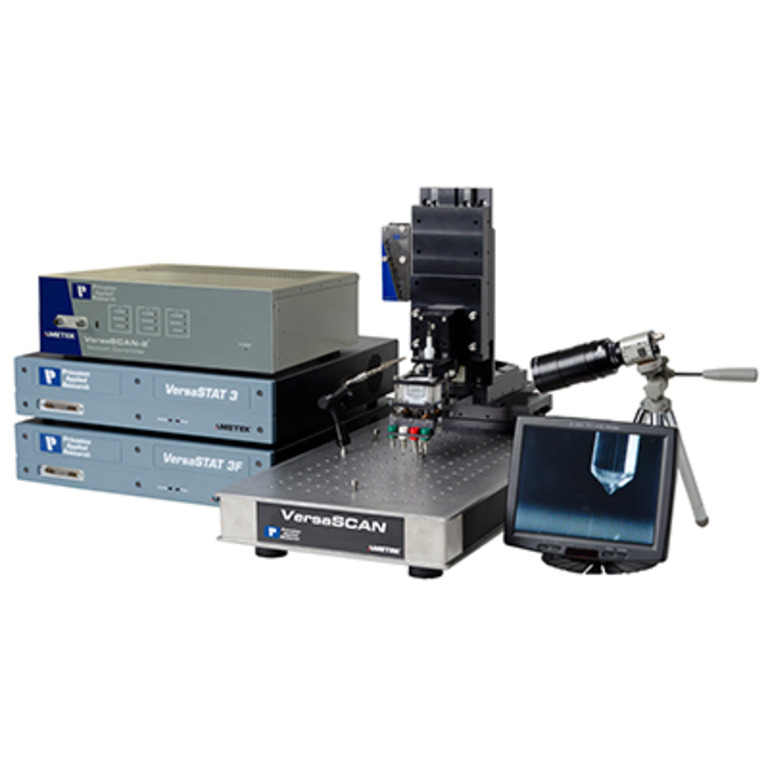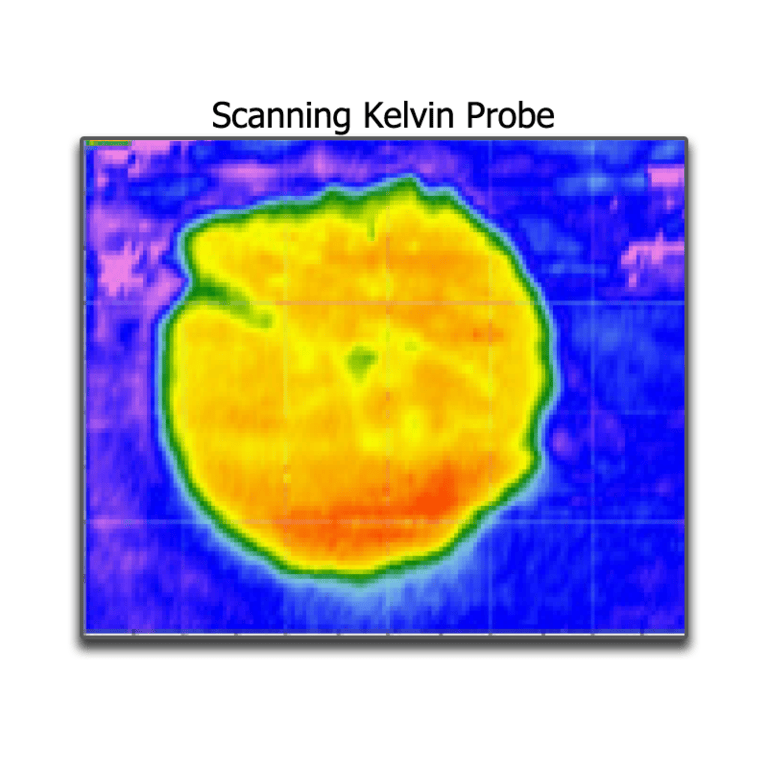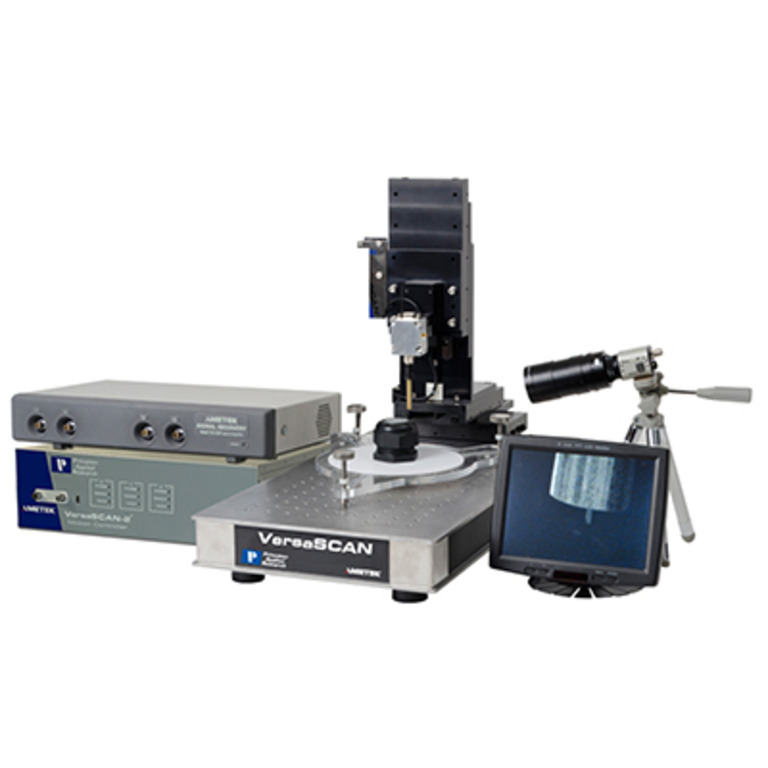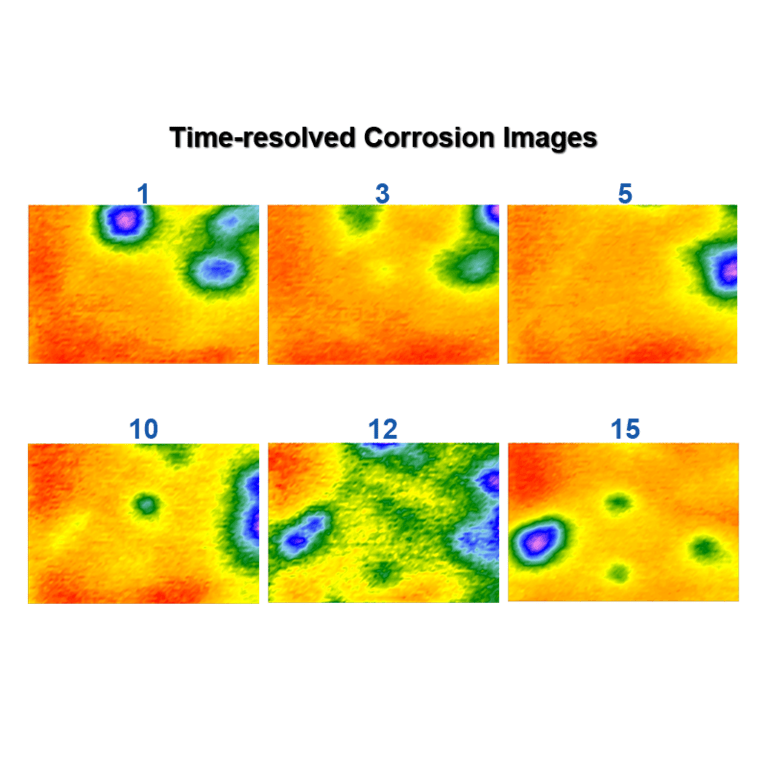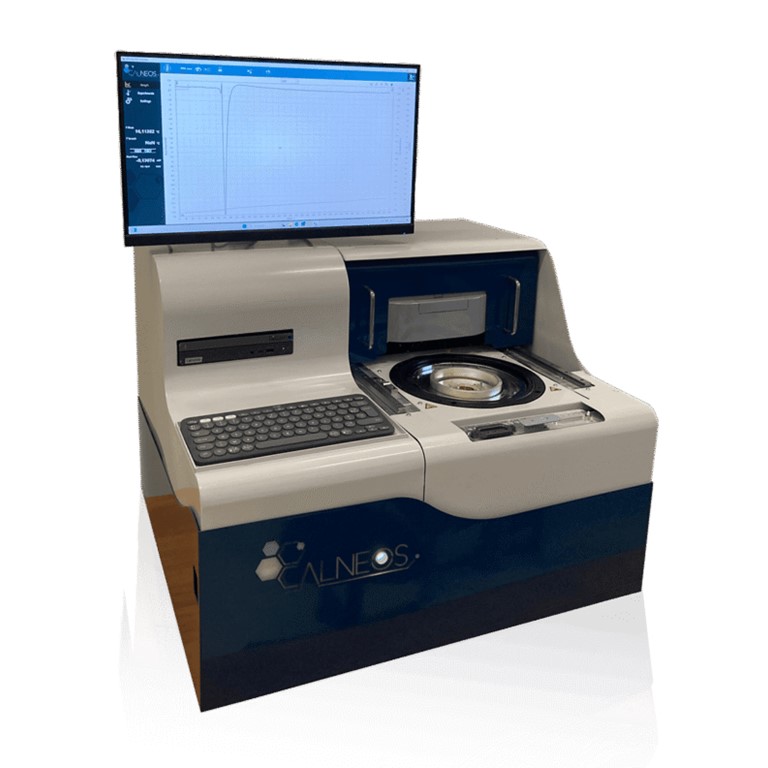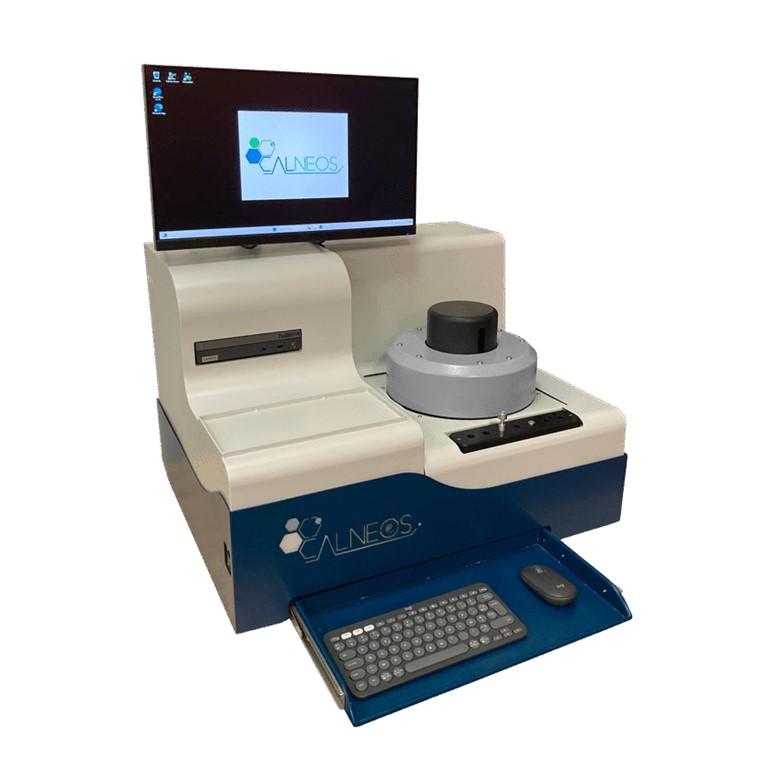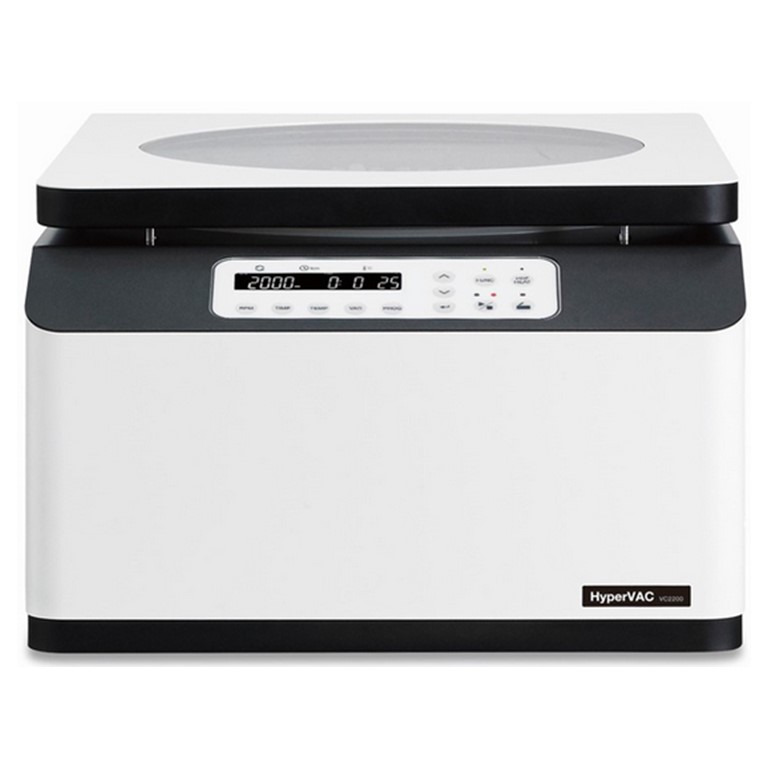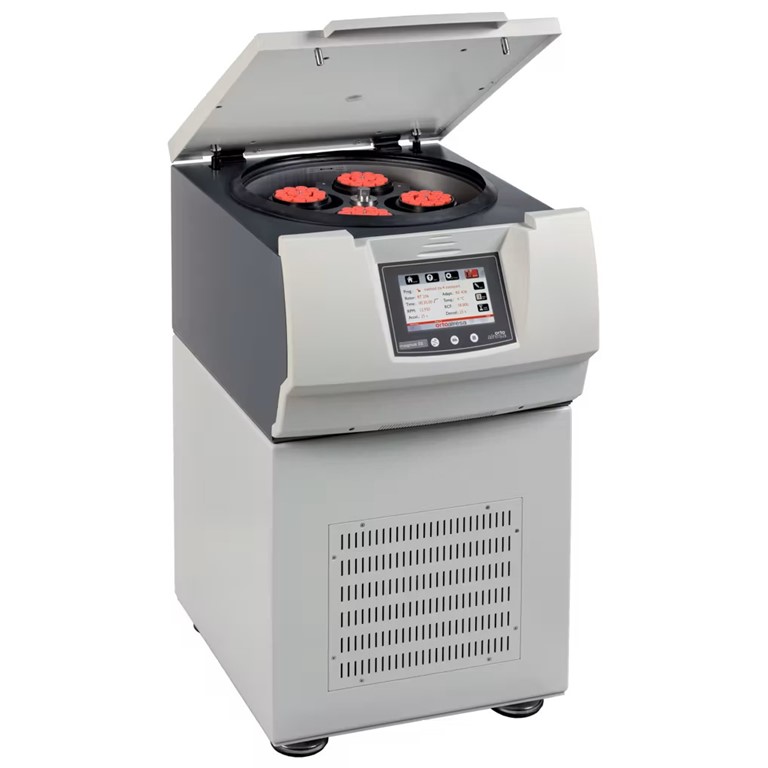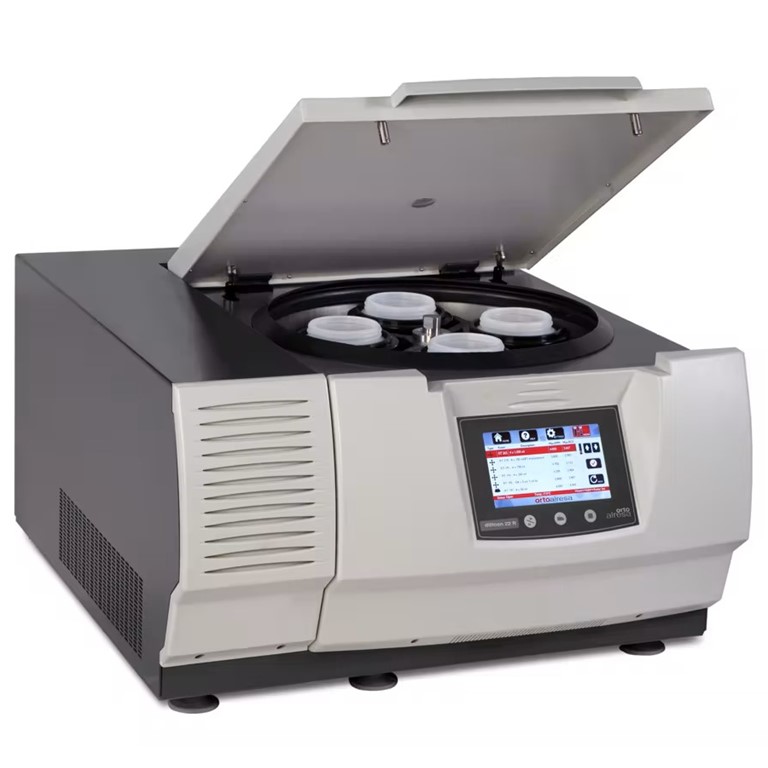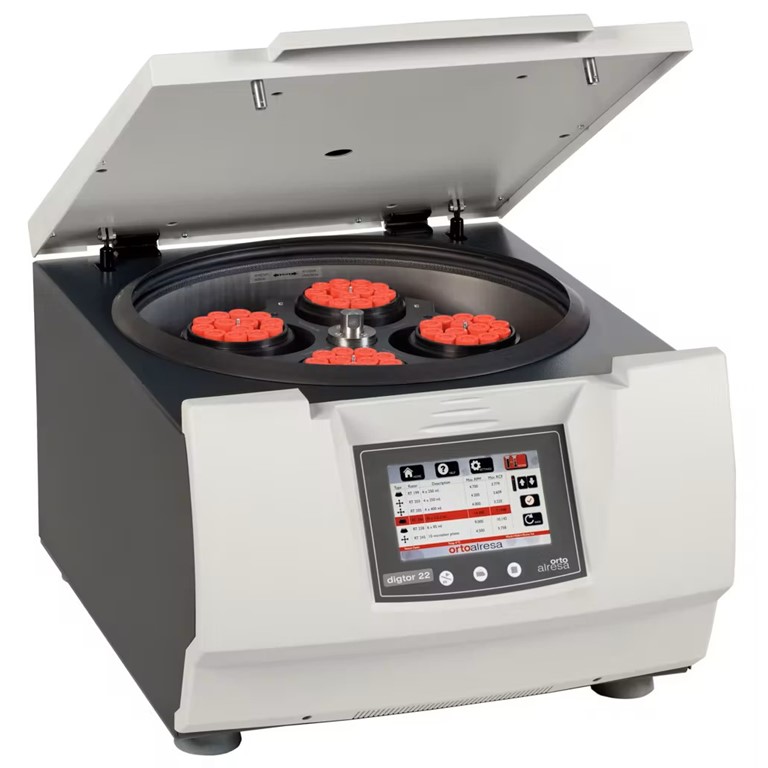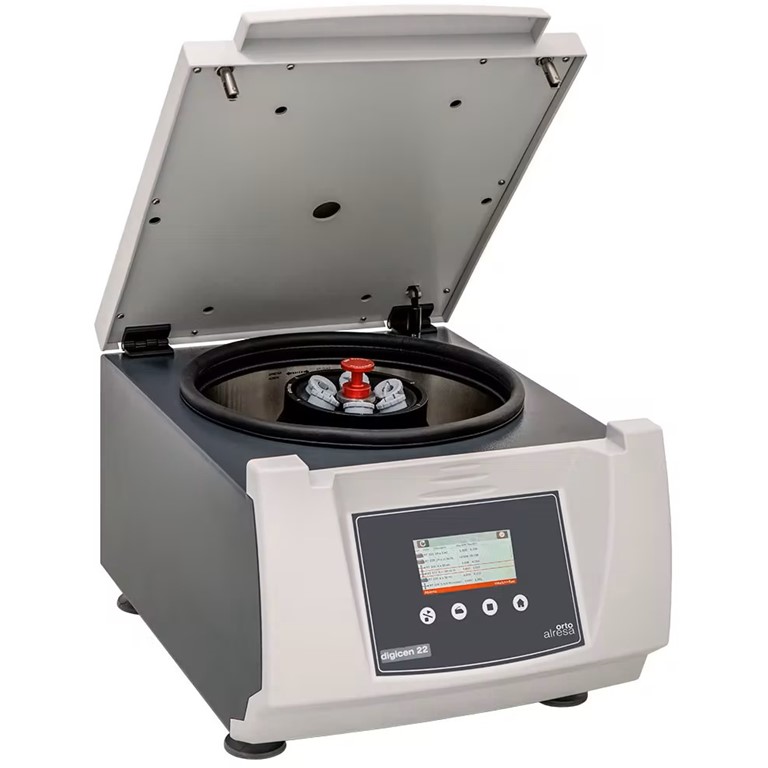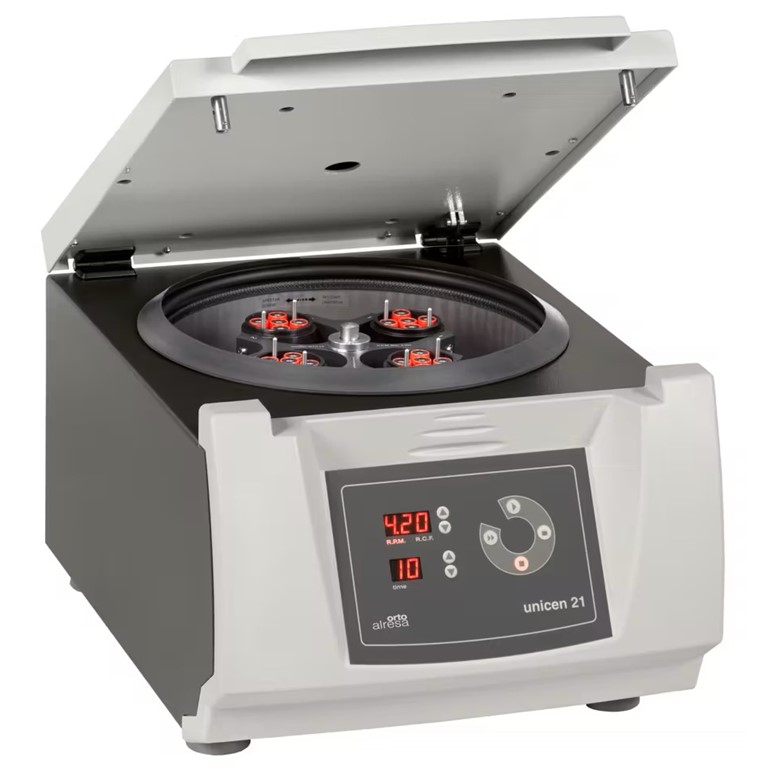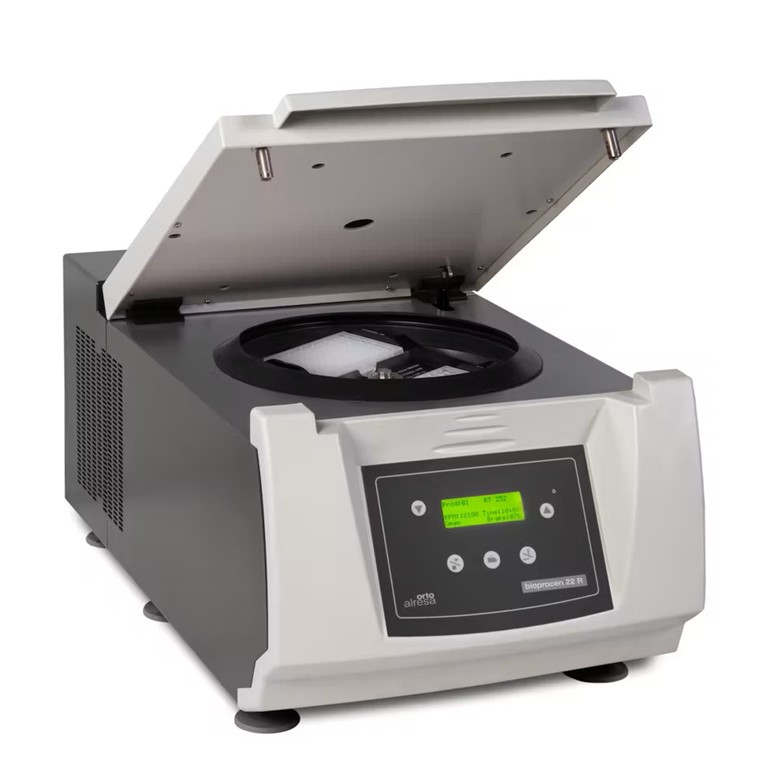Η σειρά VersaSCAN προσφέρει καινοτόμα συστήματα σάρωσης ηλεκτροχημικής ανάλυσης, παρέχοντας ακριβείς μετρήσεις σε τοπικό επίπεδο για εφαρμογές όπως SECM, SVP, και ανάλυση διάβρωσης. Ιδανική για ερευνητικά εργαστήρια και βιομηχανικές εφαρμογές, η σειρά εξασφαλίζει υψηλή ευελιξία και ακρίβεια στις πιο απαιτητικές συνθήκες.
Συστήματα Σάρωσης Ηλεκτροχημικής Ανάλυσης – VersaSCAN
Κωδικός Προϊόντος
VSC-SECM, VSC-STYLUS, VSC-LEIS, VSC-SVET, VSC-SKP, VSC-SDC, VSC-OSP
Category Ηλεκτροχημικά Συστήματα Σάρωσης
Brand: AMETEK, Princeton Applied Research
Περιγραφή
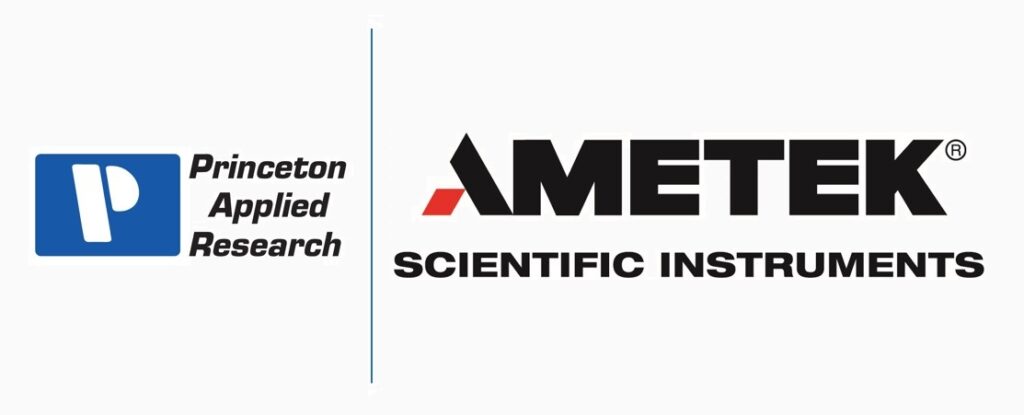
VersaSCAN Scanning Electrochemical Systems
The VersaSCAN series by AMETEK Scientific Instruments is a state-of-the-art line of scanning electrochemical systems designed for localized surface analysis with exceptional spatial resolution and precision. Developed to meet the evolving needs of electrochemical research, materials science, and surface engineering, the VersaSCAN platform offers modularity and flexibility through a range of interchangeable techniques. Each system within the series supports a specific mode of measurement, allowing users to adapt the instrumentation to their unique analytical requirements. Whether for corrosion studies, energy materials, coatings, or microstructural characterization, the VersaSCAN series provides a comprehensive and integrated solution for high-performance, spatially-resolved electrochemical investigation.
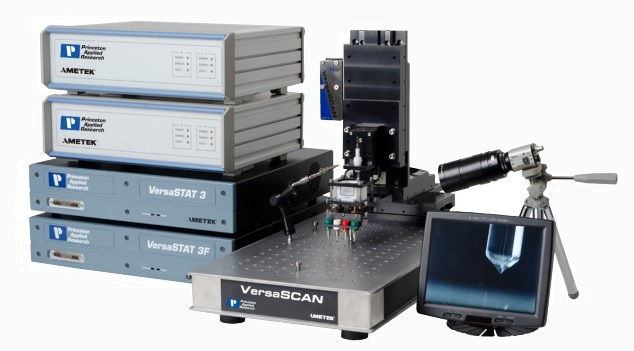
VersaSCAN Scanning Electrochemical Workstation
The VersaSCAN Scanning Electrochemical Workstation is a single platform capable of providing spatial resolution to both electrochemical and materials-based measurements. This system integrates a positioning system, measurement instrumentation, and probe to provide local information. Traditional electrochemical experiments measure an average response over the entire electrode–electrolyte interface. Rarely is a sample homogenous. Samples often consist of local sites of passivated or active nature, and sites of anodic or cathodic character. This need to investigate localized phenomena led to the emergence of scanning probe electrochemistry.
🟦 Positioning System:
➤ VersaSCAN is unique in the use of piezoelectric motors to drive the stages on all axes.
➤ Piezos are materials that move with very high precision, accuracy, repeatability but over small distances. We use them to drive stages; therefore we reach a combination of scan area and scan resolution that is unmatched.
➤ AFMs do not move with the same scan range (usually piezo-element only; without the stage).
➤ Alternative positioning system designs use step motors, exclusive or as a basis for a hybrid system, and cannot move with the same resolution.
🟦 System Installation and Training:
This is full ‘white-glove’ service. An experienced team member arrives on site – unpacked the instrumentation, assembles, levels the system.
A developed checkout procedure is executed on a test sample to verify the system (installation).
The fundamentals of the technique are covered. The users are trained to execute the same test (training).
🟦 Multi-Technique platform:
The VersaSCAN platform offers the ability to leverage the positioning system and software as common components for other scanning probe techniques.
The best-in-class measurement characteristics of AMETEK equipment combines with this unique positioning system for high-resolution measurements even at large areas.
🔵 VSC-SECM (DC and AC) Scanning Electrochemical Microscope
☑️ Most popular technique of VersaSCAN Scanning Electrochemical Workstation
☑️ SECM controls and monitors electrochemistry at a sample and probe with 2-channel potentiostat
☑️ Low Current Interface provides improved current measurement and ultimate resolution
☑️ Includes AC-SECM technique
☑️ Optional STYLUS as a soft probe for constant-distance imaging and biological applications
The VS-SECM (Scanning Electrochemical Microscope) is a highly specialized system that integrates a precise positioning platform, a bipotentiostat, and an ultramicroelectrode probe for spatially-resolved electrochemical measurements. The system allows the probe to scan across a surface within the local imaging zone, measuring current responses and producing detailed electrochemical maps. It operates in multiple modes, including Feedback Mode and Generator-Collector Mode, each enabling different interaction schemes between the probe and sample. In Feedback Mode, Approach Curves are used to position the probe at an optimal distance from the sample, where current response reveals localized electrochemical activity. Generator-Collector Mode further enhances the system’s capabilities by enabling redox cycling between the probe and sample, analogous to RRDE techniques but with added spatial resolution.
The VS-SECM platform is also compatible with AC-SECM, a technique that applies an alternating signal to the probe, enabling impedance-based imaging with or without an added mediator. This is especially useful for investigating insulating materials, surface defects, and corrosion phenomena. For applications where surface topography plays a critical role—such as in biological tissues or uneven materials—the system supports Constant Distance SECM using the Soft Stylus Probe technology developed by LEPA-EPFL. This eliminates the need for complex feedback electronics and makes it suitable for delicate or complex surfaces.
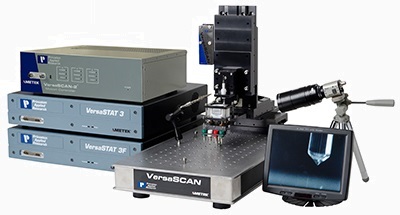
VersaSCAN’s SECM capabilities are suited for a wide range of advanced applications including corrosion analysis, catalyst evaluation, membrane studies, reaction kinetics, and biosensing. Its flexibility in both DC and AC modes, along with compatibility with multiple probe technologies and imaging techniques, positions it as a powerful tool for researchers studying localized electrochemical phenomena across materials science, energy, and biomedical fields.
🔵 VSC-STYLUS Constant Distance SECM
☑️ STYLUS is developed and supplied through exclusive partnership with SENSáSION, EPFL
☑️ Eliminates many of the experimental difficulties of Approach Curves and changing probe-to-sample distance that are associated with standard SECM techniques
In collaboration with SENSàSION, we are pleased to offer the Soft Stylus Probe contact mode technique developed by Professor Hubert Girault and co-workers of the Laboratory of Physical and Analytical Electrochemistry (LEPA) at the École Polytechnique Fédérale de Lausanne (EPFL) for constant distance SECM. The probe technology offers the following benefits:
✔️ Constant distance SECM: SECM imaging without major topographic artifacts. Ideal for tilted, corrugated, and rough samples.
✔️ Soft contact with sample: with a contact force up to 1000 times less than hard probe technology, soft probes are ideal for studying biological samples in constant distance mode SECM.
✔️ Low cost: no need for additional hardware and special feedback control electronics to control vertical position of the probe with respect to the sample. Lowest cost constant distance SECM method available on the market.
✔️ Faster measurements: no need to measure topography before SECM scans. Fast approach curve to find the sample surface.
✔️ Flexible and stable probes: no risk of damaging the probe or sample during positioning and scanning.
✔️ Small tip-to-substrate distance is easily achieved, greatly enhancing contrast imaging and improving image resolution.
✔️ Easy electrode preparation: The tip of the electrodes can be cut after each use, ensuring a clean surface. Replacement probes can be purchased.
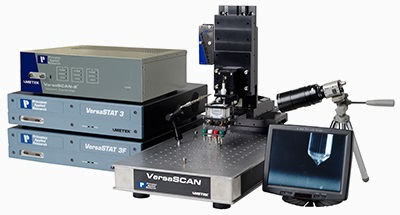
🔵 VSC-LEIS Localized Electrochemical Impedance Spectroscopy
☑️ Control voltage of a sample and use a dual-element probe to measure local current, leading to calculated local impedance
☑️ Sweep frequency at fixed position or Map area at fixed frequency
☑️ LEIS provides spatial resolution to all the applications that benefit from EIS measurements
☑️ Wide measurement bandwidth and high measurement accuracy combine to benefit local State-of-Charge (SoC) measurements and Coatings failure analysis
The VersaSTAT 3F applies an AC voltage to a sample immersed in electrolyte, generating AC current at the electrode/electrolyte interface. A dual-element probe positioned near the sample measures the local voltage-drop in the solution due to current flow from local reactions, electrolyte resistance, and spatial separation of the measurement elements. This voltage measurement is processed by the VersaSCAN’s electrometer and integrated with the VersaSTAT 3F’s Auxiliary Differential Voltage Input. The software integration converts the local voltage-drop to local AC current, enabling the calculation of localized impedance magnitude and phase shift.
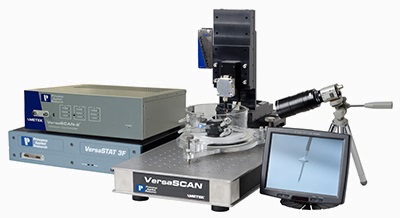
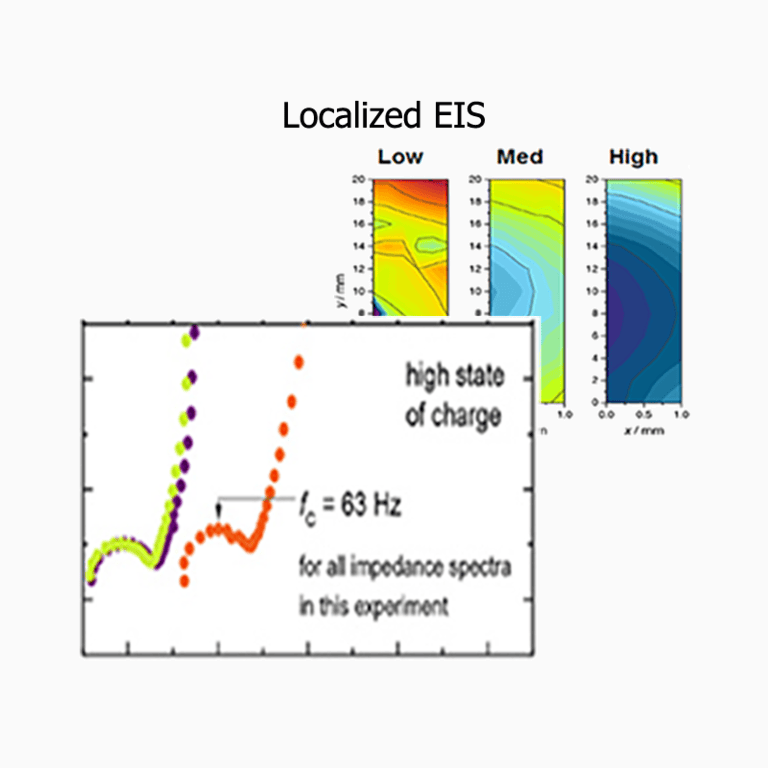
There are two different test methods for the experimentalist to use LEIS to evaluate their samples:
A) Chart the local response of a sample from a range of applied AC frequencies in a single location. Data can be viewed in either a Bode or Nyquist representation.
B) Create a series of data maps to characterize an AC response as a function of probe position. Data can be used to create a map, using either Magnitude or Phase as the response.
➤ Localized EIS measurements giving spatially resolved impedance analysis of substrates.
➤ Capable of Time-Resolved Imaging when programmed as a sequence.
➤ Single frequency or multiple frequency sweeps for complete electrochemical characterization.
🔵 VSC-SVET Scanning Vibrating Electrode Technique
☑️ Uses a Pt/Ir microelectrode to map the voltage-field in solution from local current events, such as corrosion pits or galvanic couples.
☑️ The SR 7230 ensures superior signal measurement enabling high-resolution measurements.
The Scanning Vibrating Electrode Technique uses a single wire to measure voltage drop in solution. This voltage drop is a result of local current at the surface of a sample. Measuring this voltage in solution images the current at the sample surface. Current can be naturally occurring from a corrosion or biological process, or the current can be externally controlled using a galvanostat.
The piezo unit vibrates the probe in the Z-direction (axis parallel to the sample). The amplitude of vibration may be only 10s of microns peak-to-peak. This small vibration provides a very small voltage to be measured.
Therefore, the response (signal + noise) at the probe is then gained by the electrometer. The gained output of the electrometer is then input to a Lock-In Amplifier. This, in turn, uses a phase detector along with a Reference at the same frequency of vibration to extract the small AC signal from the entire measured response. The VersaSCAN capitalizes on Ametek’s industry-leading Noise Characteristics of the Signal Recovery 7230 Lock-In Amplifier to provide superior measurement of these small signals.
The voltage recorded and the probe is repositioned. A data map results as voltage versus position are displayed.
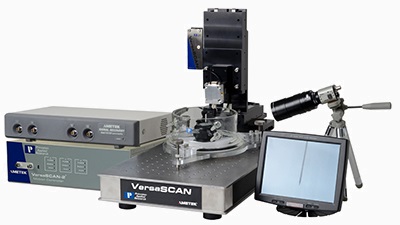
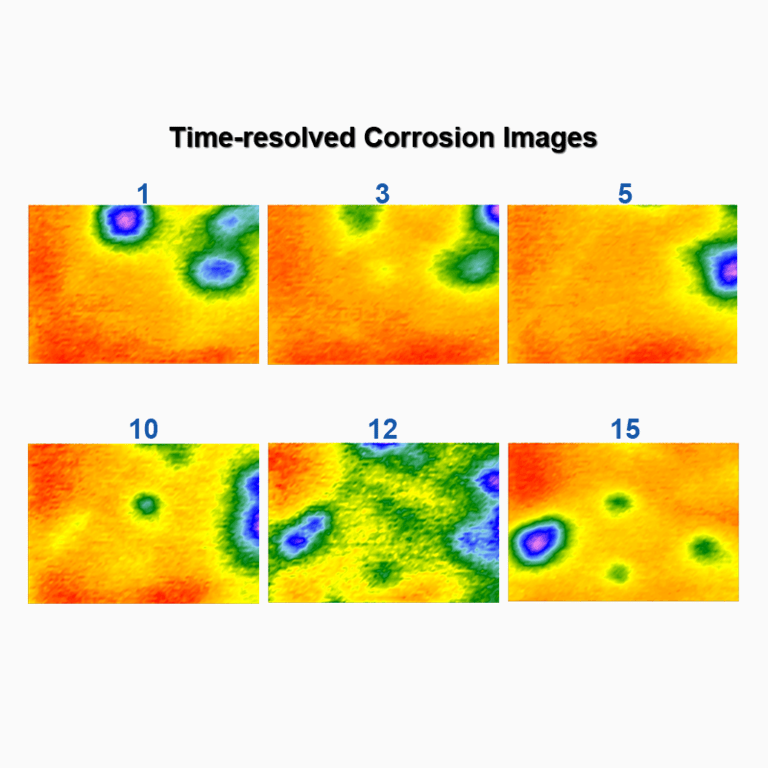
A key application of SVET is to study corrosion process of bare metals. These metals could be galvanic couples or could occur from local non-uniform corrosion events, such as pits or crevices.
Time-lapse experiment series provide the capability to literally watch the corrosion events happen – as different areas passivate and activate.
Additionally, there are many applications and references for the use and results of SVET used in biological systems.
➤ Measures localized voltage gradient between tip and substrate for determination of localized current density.
➤ Developed for analysis of non-uniform corrosion events, such as pits, welds, and galvanic couples.
➤ Capable of Time-Resolved Imaging when programmed as a sequence.
🔵 VSC-SKP Scanning Kelvin Probe Microscope
☑️ Uses a relative work function measurement, typically in atmospheric conditions, to map the anodic and cathodic nature of samples
☑️ Superior probe design and signal measurement capability provide high resolution measurements
The Kelvin Probe experiment uses a nondestructive method to determine the relative work function difference between the probe and the sample. Work function describes the energy required to liberate an electron from the surface of a conductor; electrochemists often interpret this as the difference from an electrode’s Fermi Level, average energy of electrons, and that of vacuum.
A metal microprobe is positioned close to the surface of the sample (on the order of 100-microns). If the microprobe and sample are of different metals, there is an energy difference between their electrons. The microprobe is then electrically shorted to the sample, through internal electronics of the system. As a consequence, one metal forms a positive charge on its surface and the other metal forms a negative charge on its surface. The probe and sample are separated by a dielectric (air), so a capacitor is formed. The probe is then vibrated and “backing potential” or “nulling potential” is then applied sufficient to minimize this capacitance. At the applied voltage that causes the capacitance to go to zero, the original state is achieved. This value is recorded and charted.

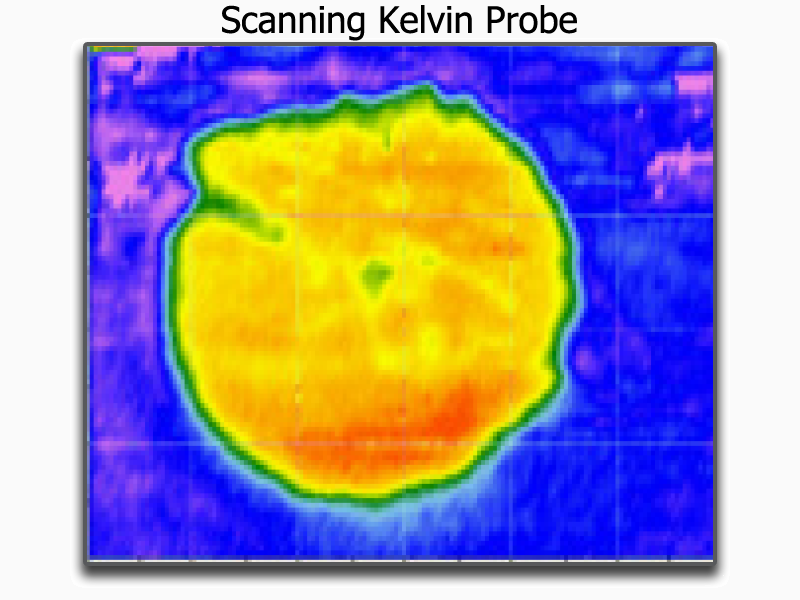
Experiments are typically performed in ambient gaseous conditions, but several published examples use humidified environments. The underlying conducting sample can have an organic coating or paint applied.
This relative work function can also be correlated to an Ecorr value.
Our SKP is also capable of functioning in Topography Mode. Without changing connections or probe, a reference voltage is applied to the sample. This reference voltage makes the surface of the sample uniform. Change in capacitance is then from a changing plate separation (via equation of a capacitor).
This information can be used in 2 ways: Position the probe a known distance from the sample, using a Calibration Coefficient.
Map topography for further use in Constant-Distance Mode SKP. This is particularly useful in studying welds or other samples of complex topography.
➤ Measures relative work function between probe and sample.
➤ Can correlate Work Function to Corrosion potential (Ecorr).
➤ Capable of Topography Mode experiments to measure and set probe-to-sample distance
➤ Can perform Constant-Distance operation in conjunction with the Topography Mode experiments, using the same probe.
🔵 VSC-OSP Non-contact Optical Surface Profiler
☑️ OSP uses laser-based technology to accurately map topography of any sample.
☑️ When combined with other techniques, OSP data provides a mechanism for Constant-Distance measurements, removing a key complication of data interpretation.
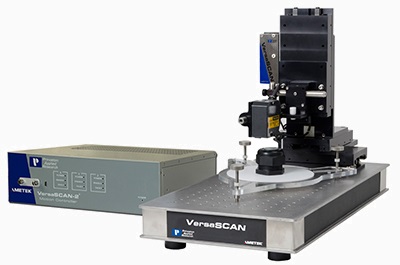
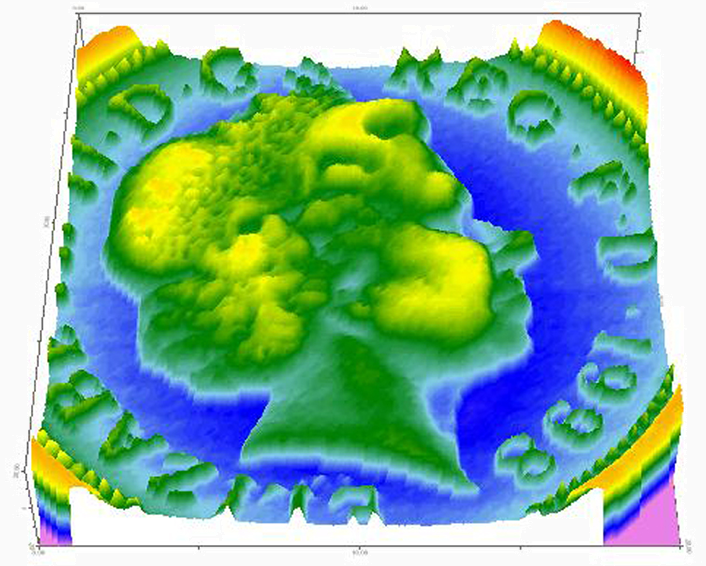
The VersaSCAN OSP integrates the Base with a high-accuracy, high-speed laser displacement sensor. The OSP technique uses diffuse reflection mechanism to measure topography of a sample. OSP can be used to measure topography, as a very sensitive leveling mechanism, or charting topography to be implemented with other scanning probe techniques for constant-distance mode operation.
➤ Optical Surface profiling technique to measure topography of sample
➤ Can be combined with other VersaScan techniques for constant distance mode mapping
ΙΔΑΝΙΚΟ ΓΙΑ
☑️ VSC-SECM (DC και AC) – Σάρωση Ηλεκτροχημικής Μικροσκοπίας
-
-
Εφαρμογή: Υψηλής ανάλυσης απεικόνιση και ανάλυση ηλεκτροχημικών αντιδράσεων σε μικροσκοπική και νανοσκοπική κλίμακα.
-
Χαρακτηριστικά: Δυνατότητες μέτρησης DC και AC για ολοκληρωμένη ηλεκτροχημική ανάλυση.
-
☑️ VSC-STYLUS – Σάρωση SECM με Σταθερή Απόσταση
-
-
Εφαρμογή: Διατήρηση σταθερής απόστασης μεταξύ του αισθητήρα και του δείγματος, παρέχοντας ακριβείς και συνεπείς μετρήσεις.
-
Χαρακτηριστικά: Ιδανικό για ευαίσθητες εφαρμογές που απαιτούν σταθερή απόσταση κατά τη διάρκεια της ανάλυσης.
-
☑️ VSC-LEIS – Τοπική Ηλεκτροχημική Απεικόνιση Αντίστασης
-
-
Εφαρμογή: Μέτρηση τοπικής αντίστασης για ενδελεχή ανάλυση επιφανειών και κινητικής αντιδράσεων.
-
Χαρακτηριστικά: Ιδανικό για την μελέτη ετερογενών υλικών και πολύπλοκης συμπεριφοράς επιφανειών.
-
☑️ VSC-SVET – Σάρωση Ηλεκτροδίου με Δόνηση
-
-
Εφαρμογή: Μέτρηση της κατανομής δυναμικού και ρεύματος, χρησιμοποιούμενη ευρέως σε έρευνες διάβρωσης.
-
Χαρακτηριστικά: Χρησιμοποιεί ηλεκτρόδιο με δόνηση για την χαρτογράφηση των ηλεκτροχημικών χαρακτηριστικών της επιφάνειας.
-
☑️ VSC-SKP – Σάρωση Αισθητήρα Κέλβιν
-
-
Εφαρμογή: Μέτρηση παραλλαγών του δυναμικού επιφάνειας και του έργου λειτουργίας, σημαντική για τον χαρακτηρισμό υλικών.
-
Χαρακτηριστικά: Παρέχει γνώσεις για την επιφανειακή ενέργεια και τις ηλεκτροχημικές ιδιότητες χωρίς επαφή.
-
☑️ VSC-SDC – Σάρωση Κελιού Σταγόνας
-
-
Εφαρμογή: Ιδανικό για μελέτες ηλεκτροχημικών αντιδράσεων σε μικρές περιοχές, εφαρμόζοντας σταγόνες ηλεκτρολύτη στην επιφάνεια του δείγματος.
-
Χαρακτηριστικά: Επικεντρώνεται σε τοπικές μετρήσεις για ακριβείς μελέτες επιφανειών.
-
☑️ VSC-OSP – Ανέπαφος Οπτικός Χαρτογράφος Επιφανειών
-
-
Εφαρμογή: Χωρίς επαφή τοπογραφική χαρτογράφηση επιφανειών, παρέχοντας λεπτομερή προφίλ επιφανειών.
-
Χαρακτηριστικά: Υψηλή ανάλυση προφίλ για ανάλυση τραχύτητας και δομής επιφανειών.
-
ΠΑΡΟΜΟΙΑ ΠΡΟΪΟΝΤΑ
Η έκδοση χαμηλών θερμοκρασιών του Ultimate DSC, εξοπλισμένη με εξαι…
Θερμιδόμετρο τελευταίας τεχνολογίας και υψηλής ευαισθησίας, με επαν…
Εξαιρετικά ευαίσθητο μικρο-θερμιδόμετρο που προσφέρει κορυφαία ακρί…
Οι Συλλέκτες Δείγματος υπό Κενό, HyperVAC-MAX & HyperVAC-LITE της G…
Οι υπερφυγόκεντροι της Gyrozen συνδυάζουν ακρίβεια, αξιοπιστία και κα�…
Οι Magnus 22 & 22 R είναι επιδαπέδιες φυγόκεντροι υψηλής χωρητ…
Η Dilitcen 22 R είναι επιτραπέζια φυγόκεντρος υψηλής χωρητικότητας με �…
Οι Digtor 22 και 22 R είναι επιτραπέζιοι φυγόκεντροι υψηλής χωρητ�…
Οι Consul 22 & 22 R είναι φυγόκεντροι υψηλής χωρητικότητας, συμ�…
Η Digicen 22 είναι μια universal φυγόκεντρος με πλήρη γκάμα ρότορων για �…
Η Unicen 21 είναι μια πολυλειτουργική φυγόκεντρος με ποικιλία ρότορων κ…
Η Bioprocen 22 R είναι μια πολυλειτουργική ψυχόμενη φυγόκεντρος για μι…

